Written by Karen Ballantyne (@keballantyne), Graham Brownlee (@GrahamBrownlee) and Hanno Southam (@hannosoutham)
Bristol Bay – a unique set of circumstances
Set in the rugged wilderness of southwestern Alaska, nine rivers flow into Bristol Bay. The Togiak, Igushik, Wood, Nushagak, Kvichak, Alagnak, Naknek, Egegik and Ugashik rivers are home to a number of salmon subspecies which make up the largest sockeye salmon run in the world (Fig 1). A record breaking 61 million salmon headed home in 2018. Waiting for them was one of the most intense commercial salmon fisheries on earth.
The History
Commercial fishing started in Bristol Bay in 1884 with a small fishery and cannery operation when Alaska was just a territory of the US. The abundance of salmon in the Bay quickly drew more fishers and cannery operators to the area. In the following decades the combination of poor management and increased fishing decimated the salmon populations to the point where the Wood and Nushegak rivers were closed to commercial fishers in 1908. In an attempt to help salmon populations recover, the University of Washington developed and put in place escapement goal protocols on the Wood River in 1954 and on other rivers in the following years. But the salmon still weren’t doing well and in 1972/1973 their population crashed. At this time Alaska, which gained statehood in 1960, introduced a Limited Entry Permit system. This combination of escapement goal protocols and the Limited Entry Permit system form the modern management strategy.

Fig 1. Map of Bristol Bay river districts (reprinted USEPA, 2014, Appendix A).
The Strategy
Escapement refers just to the number of spawning fish reaching the spawning grounds. It is the foundation of Alaska’s salmon management and takes complete priority; that is, escapement (sustainability) comes first and everything else second. Escapement is estimated during the run the old-fashioned way: counting fish from towers, 24-hours a day. When, and only when, escapement is on track to meet its goals is the fishery opened. Coupled with the escapement strategy is the Limited Entry Permit system that restricts the size of the fishing fleet. Permits were given to fishermen who could prove they had participated in the fishery since it began. They are finite in number, transferable and divided up by two gear types, setnets (shore-based) & driftnets (vessel-based). When the fishery is opened there is no limit on the catch and, as of late, plenty of salmon to fill the nets. Managing all this are three Area Management Biologists from the Alaska Department of Fish and Game (ADF&G). They hold complete authority over the fishery and the responsibility for the millions of running salmon and the livelihoods it supports.

Setnetters at work (NPS Photo/ James Kramer)

Driftnetters at work (NOAA Historic fisheries collection)
Our Assessment
- We had three goals for our project:
- Assess the biological state of Bristol Bay sockeye since the start of the modern management strategy.
- Determine if these biological changes have, or have not, supported economic growth in the Bristol Bay commercial fishery.
- Recommend options to improve Bristol Bay’s economics while maintaining the ecological sustainability of the fishery.
The Results
Under the modern management structure (1973-onward), it is clear that Bristol Bay’s sockeye populations have strongly rebounded since the crash of 72-73 (Fig 2). In other words, there is more fish. Escapement goals set by the ADF&G Area Biologists have been consistently met or exceeded on almost every river system (Fig 3).
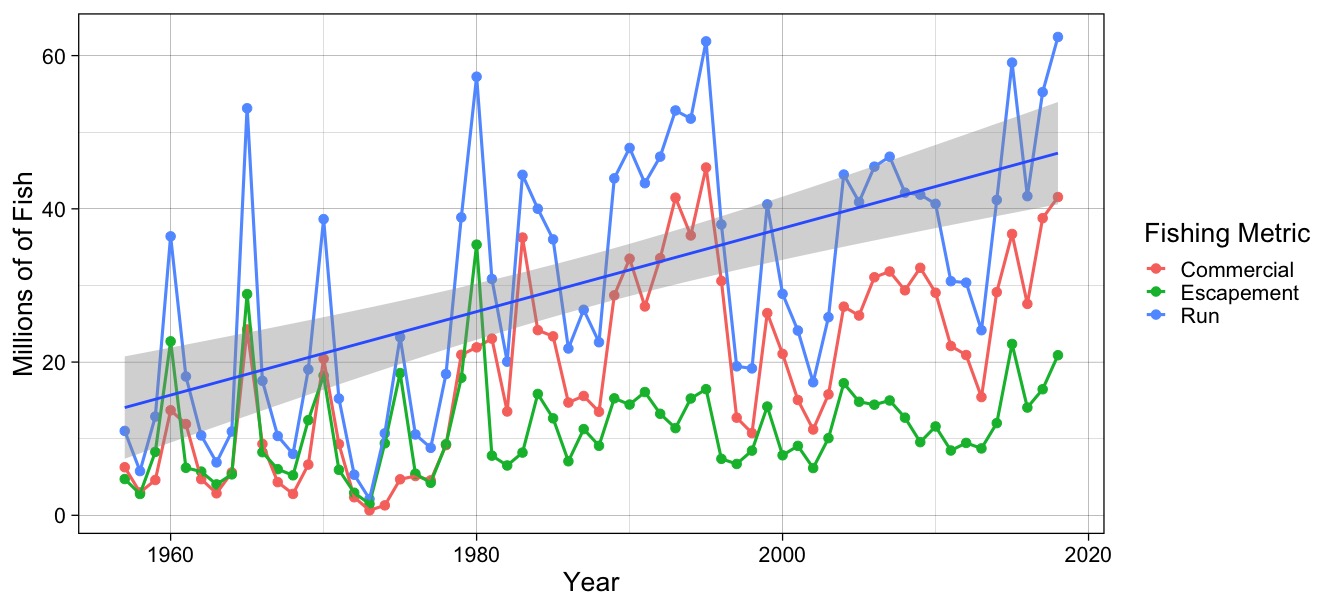
Fig 2. Total run (catch + escapement) (blue), commercial catch (red), and escapement (green) of sockeye salmon from 1956-2018. Note the historic low (2.4 million fish) in 1973 and increase in run size from that point onward to a historic high in 2018 (61 million).

Fig 3. Commercial catch (light grey) and escapement (dark grey) in the Ugashik river 1980 to 2009. Solid lines are upper and lower bounds of escapement goals. Any year with a dark bar above the lower line means escapement was met. Important here is that escapement is met every year and that this pattern is true for every other river (reprinted from English et al., 2011, pg. 141-143).
The economics of Bristol Bay post-1973 are less clear. The total value (wholesale) of the fishery has steadily increased since the most recent crash from 1997 to 2003 (Fig 4). Peaks in production (total weight of fish) have not matched the market price fishers received. The years with the greatest net weight (1993-1996 and 2015-2017) do not align with the greatest price per pound the fishers earned for their catch, and relatively low production often occurred in the years where prices were greatest (1986, 1988, 1998 and 2014) (Fig 5).
Japan was once the largest importer of Alaskan sockeye in the world, but between 1985 and 2004 the export of product to Japan dropped dramatically and was replaced by farmed species (coho and rainbow trout) from Chile and Norway. More generally, this period corresponds to increased global production of farmed salmon and decreasing prices for wild-caught salmon (Fig 6).
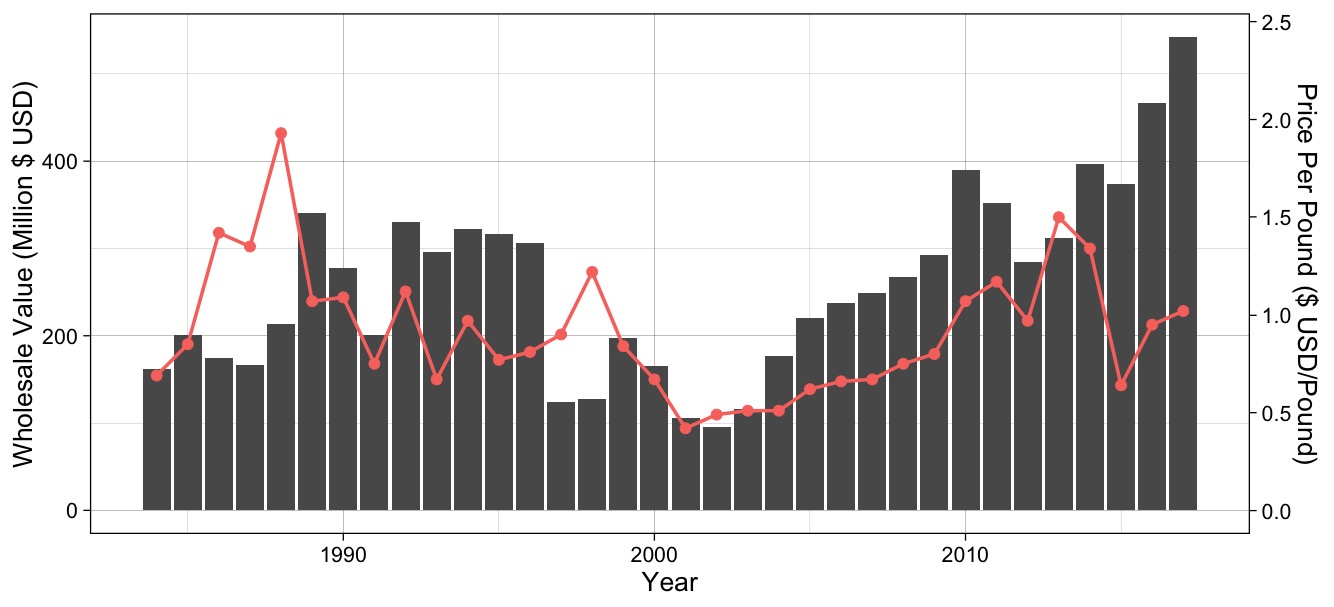
Fig 4. Time series of Bristol Bay sockeye wholesale value (grey bars, left axis) and market value (red line, right axis) from 1984 to 2017. From 2004 onward, there are clear upward trends in sockeye market price and the wholesale value produced by the fishery.
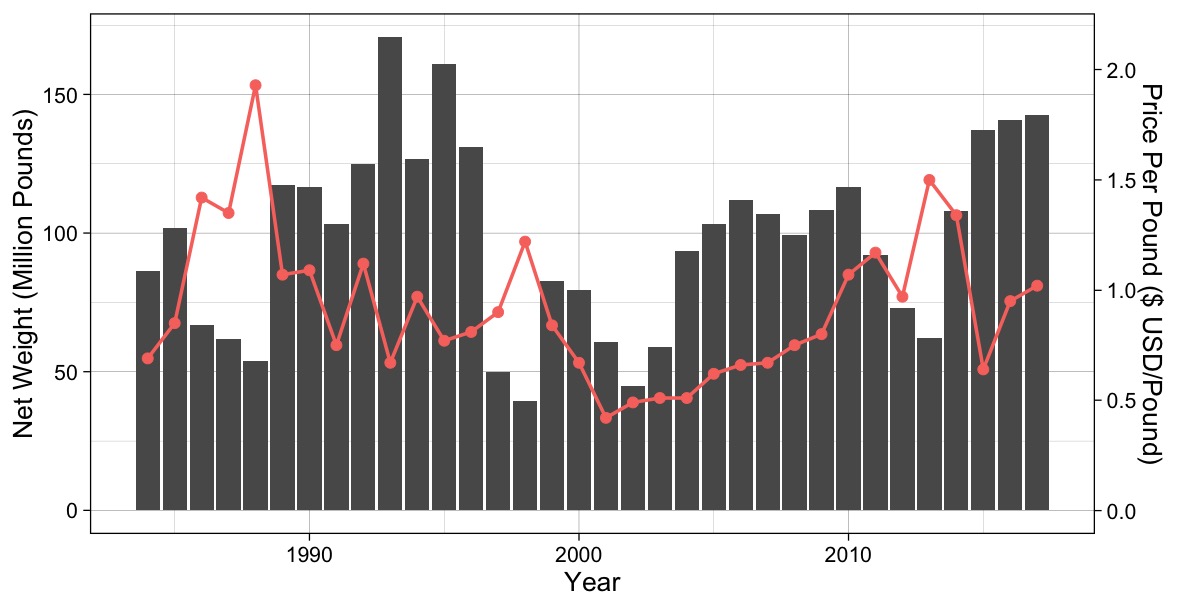
Fig 5. Time series of Bristol Bay sockeye net weight caught (grey bars, left axis) and market value (red line, right axis) from 1984 to 2017. In this graph, large gaps between the net weight fishers caught and price per pound fishers received are apparent, especially between 1986-1996 and 2004-2010.
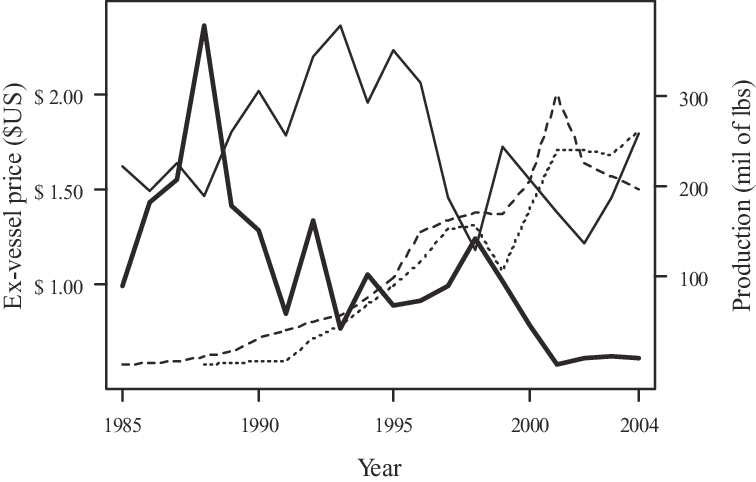
Fig 6. Time series from 1985-2004 of exvessel prices (price per-pound) and fish production (millions of pounds). The thick solid black line represents exvessel prices for Bristol Bay sockeye, the thin solid black line represents total production of Alaskan sockeye and the dashed (Chilean coho salmon) and solid (Chilean rainbow trout) lines represent Chilean farmed fish production. Over this time period, production of Alaskan sockeye remained relatively constant, but farmed fish production increased dramatically, and exvessel prices began to crash. Reprinted from Steiner, Criddle and Adkison (2011).
The Ecology-Economics Problem
Bristol Bay is a well-demonstrated biological success. Whether this has translated to economic success is less clear. We thought about this ecology-economics problem in three ways:
Changes on the Inside: the Management Strategy
All of Alaska’s salmon fisheries, Bristol Bay included, must try to maximize the total number of returning fish each year. This requires having had years with few returning fish and years with huge numbers of returning fish to know which number of fish corresponds to maximum production. But changing the escapement goals that determine how many fish are allowed to spawn is risky – raising or lowering escapement can have unexpected or harmful consequences to the fishery in the long-term. Instead, the Bristol Bay managers keep the goals constant, which minimizes the risks associated with attempting to identify where peak production occurs. This conservative strategy has caused the fishery to miss out on a potential 35% increase in production and 2.2 billion USD in value between 1956 and 2004.
Changes on the Outside: Fish sticks or fillets
Factors outside the management strategy of Bristol Bay have strongly improved its economics. As more fish consistently returned to the bay post-1973, shifts in global tastes away from Alaskan sockeye to farmed salmon caused market prices to crash, wages for fishers to plummet and for Bristol Bay to be ruled an economic disaster. Post 2004, however, the economics got better. Fishers have transitioned from low-quality canned salmon to high-quality fillets, began to process their fish onboard and have sold more fish to the more stable, higher value US market over other markets. This economic recovery of the fishery would not have been possible without steady improvements in sockeye populations due to the escapement management strategy.
Bristol Bay: the Oddball in Global Fisheries
Our assessment of Bristol Bay follows others in declaring the modern escapement strategy a clear ecological success – no matter which way you look at it. Those who called Bristol Bay an economic failure focused only on the management. When you expanded your view of the fishery to a broader context that includes social and economic factors it becomes clear that there are other things that have/are driving economic returns. And if you take one more step back to view Bristol Bay in a global fisheries context, Bristol Bay becomes a unique example where long-term biological sustainability has taken complete priority over short-term economic gain. This makes the traditional definition of economic success that requires maximized profits insufficient.
Resolving The Problem
The difficult problem in fisheries is integrating ecological sustainability with economic success. Exploring the upper bounds of the escapement goals to better identify the optimal productivity is worthwhile, but should not risk biological sustainability. Perhaps more important is to acknowledge and explore options outside of management, like what the fish are sold as and which markets the fish are sold to. And finally, the fishery must be examined in the context of an global fishing industry where the repeated plundering of stocks is the norm. The rarity of this example, as a fishery where economic return is positive but not maximized and the health of the fish stock is given top priority, makes Bristol Bay both a biological and economic success.
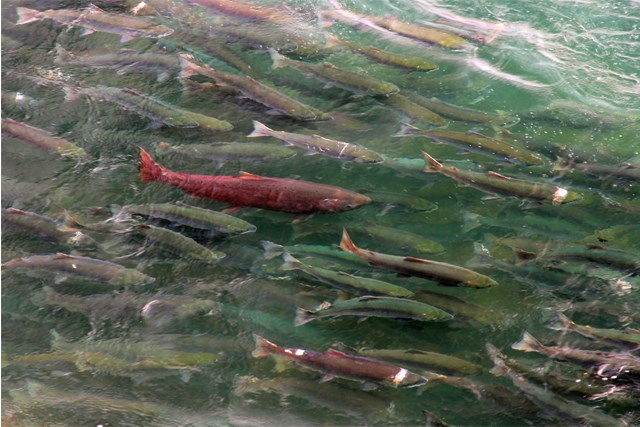
Salmon running in Lake Clark National Park & Preserve, Alaska (Steve Huffman).
Useful Links
Bristol Bay Economic Development Corporation
Bristol Bay Science and Research Institute
Bristol Bay Fisheries Collaborative
Alaska Department of Fish and Game
References
English K.K., Edgell T.C., Bocking R.C., Link M., Raborn S. (2011). Fraser River Sockeye Fisheries and Fisheries Management and Comparison with Bristol Bay Sockeye Fisheries. LGL Ltd.Cohen Commission Tech. Rept. 7: 190p & appendices. Vancouver BC.
Steiner, E.M., Criddle, K.R. & Adkison, M.D. (2011). Balancing Biological Sustainability with the Economic Needs of Alaska’s Sockeye Salmon Fisheries. North American Journal of Fisheries Management, 31(3), 431-444.
USEPA (U.S. Environmental Protection Agency). (2014). An Assessment of Potential Mining Impacts on Salmon Ecosystems of Bristol Bay, Alaska. Region 10, Seattle, WA. EPA 910 R-14-001.